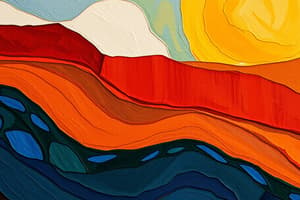Podcast
Questions and Answers
What is the meaning of the word 'igneous'?
What is the meaning of the word 'igneous'?
- Formed under pressure
- Formed from sediment
- Formed from magma
- Fire (correct)
How are igneous rocks formed?
How are igneous rocks formed?
- When rocks are exposed to air
- When magma cools and crystallizes (correct)
- Through the compression of sediment
- Through erosion and deposition
What determines the type of crystals formed in igneous rocks?
What determines the type of crystals formed in igneous rocks?
- The temperature of the magma
- The composition of the magma (correct)
- The rate of cooling of the magma
- The pressure under which the magma cools
What is crystallization?
What is crystallization?
What is the difference between intrusive and extrusive igneous rocks?
What is the difference between intrusive and extrusive igneous rocks?
What affects the appearance of igneous rocks?
What affects the appearance of igneous rocks?
What is the rock cycle?
What is the rock cycle?
What is the primary factor that determines the texture of igneous rocks?
What is the primary factor that determines the texture of igneous rocks?
Which type of igneous rock is formed when lava cools quickly?
Which type of igneous rock is formed when lava cools quickly?
What is the characteristic texture of obsidian?
What is the characteristic texture of obsidian?
What is the typical silica content of felsic rocks?
What is the typical silica content of felsic rocks?
Which type of rock is characterized by a bubbly texture?
Which type of rock is characterized by a bubbly texture?
What is the name of the texture that features a mixture of large and small mineral grains?
What is the name of the texture that features a mixture of large and small mineral grains?
Which type of rock is classified as having a high magnesium and iron content?
Which type of rock is classified as having a high magnesium and iron content?
What is the term used to describe rocks with a high silica content?
What is the term used to describe rocks with a high silica content?
Flashcards are hidden until you start studying
Study Notes
Igneous Rocks Formation
- Igneous rocks are formed from the cooling and crystallization of magma or lava.
- Magma is molten rock under Earth's surface, and it can cool and solidify above or below the surface.
- The cooling process determines the type of crystals formed, which in turn affects the appearance of the igneous rock.
Types of Igneous Rocks
- There are two main types of igneous rocks: intrusive and extrusive.
- Intrusive rocks form below Earth's surface, where magma cools slowly, allowing for large crystal formation.
- Extrusive rocks form above ground, where lava cools quickly, resulting in fine-grained or glassy textures.
Intrusive Igneous Rocks
- Also known as plutonic rocks.
- Formed when magma cools slowly inside Earth's surface.
- Coarse-grained and rough-textured due to slow cooling.
- Examples: granite.
Extrusive Igneous Rocks
- Also known as volcanic rocks.
- Formed when lava cools quickly above ground.
- Fine-grained or glassy textures due to quick cooling.
- Examples: obsidian, pumice.
Igneous Rock Textures
- Texture depends on cooling rate.
- Porphyritic texture: two distinct sizes of minerals, with larger minerals mixed with smaller groundmass.
- Phaneritic texture: slow cooling, coarse-grained, with large interlocking crystals.
- Aphanitic texture: fast cooling, very fine-grained, with microscopic crystals.
- Glassy texture: fast cooling, smooth like glass.
Classification of Igneous Rocks
- Igneous rocks can be classified according to mineral content, particularly silica dioxide.
- Felsic rocks: light in color, contain >65% silica dioxide, with abundant quartz and feldspar.
- Mafic rocks: darker and denser, contain 45-55% silica dioxide, with abundant magnesium and iron.
- Ultramafic rocks: very low silica content (<45%), with abundant magnesium and iron.
- Examples: rhyolite (felsic), basalt (mafic), peridotite (ultramafic).
Studying That Suits You
Use AI to generate personalized quizzes and flashcards to suit your learning preferences.



